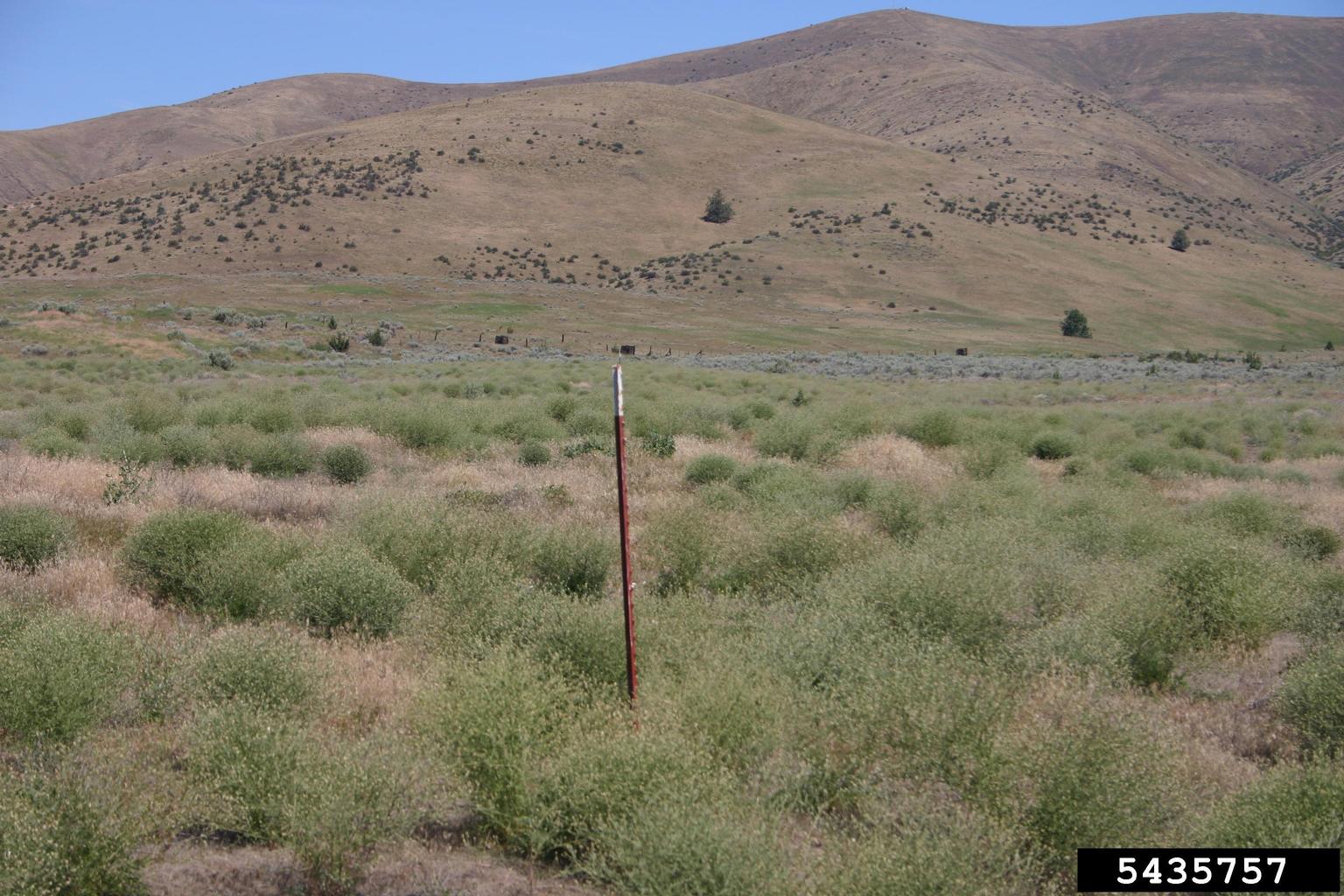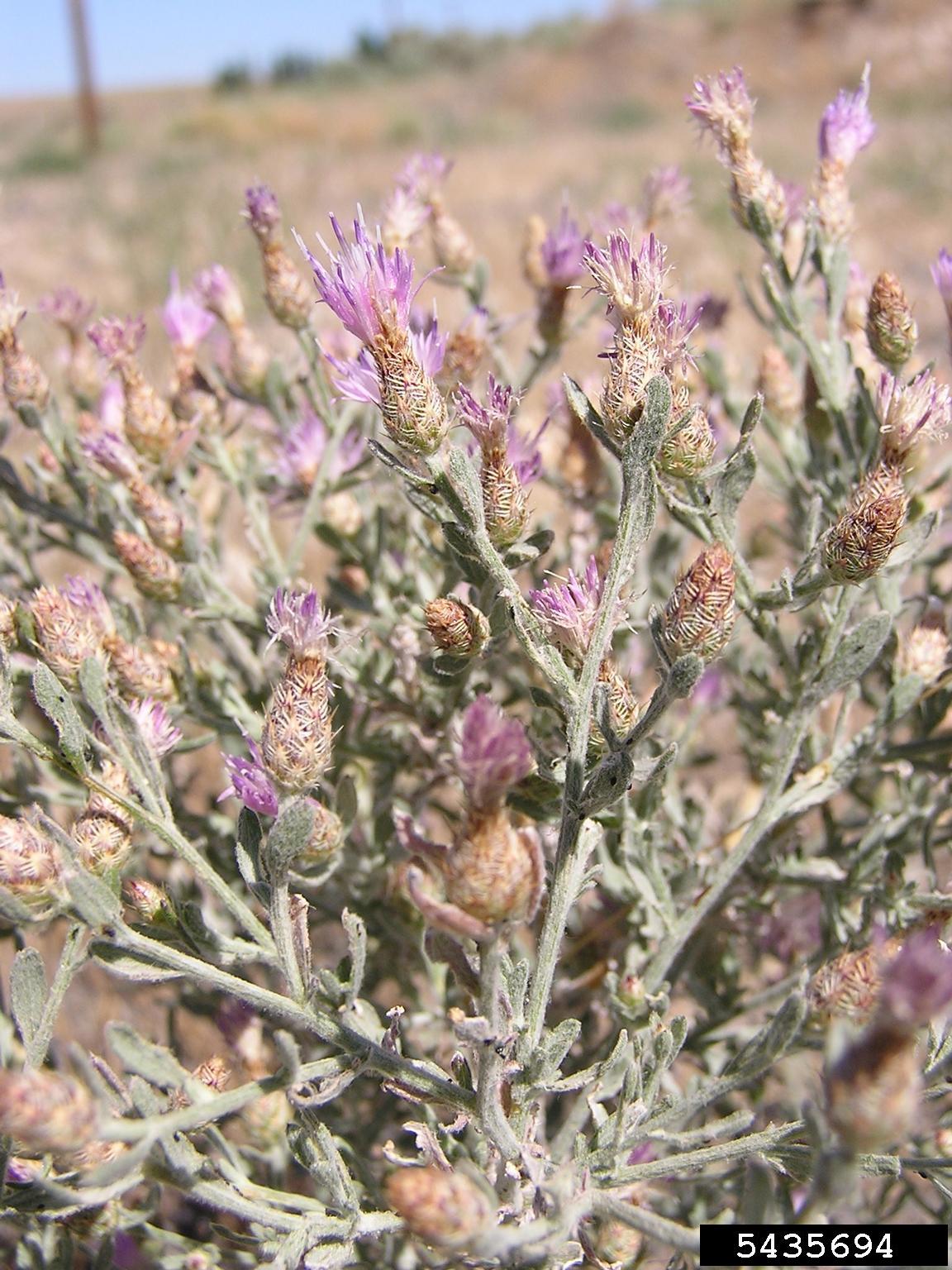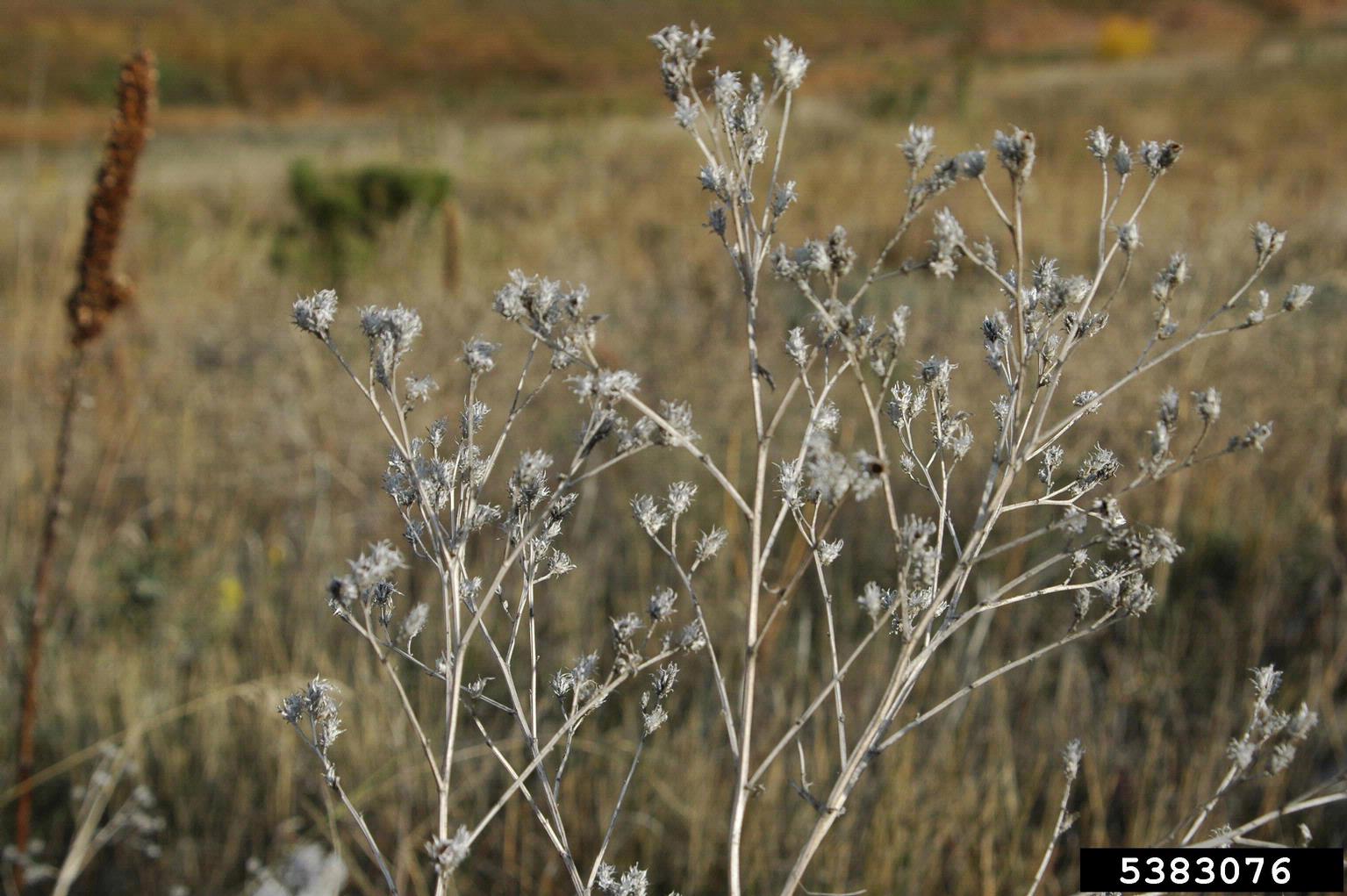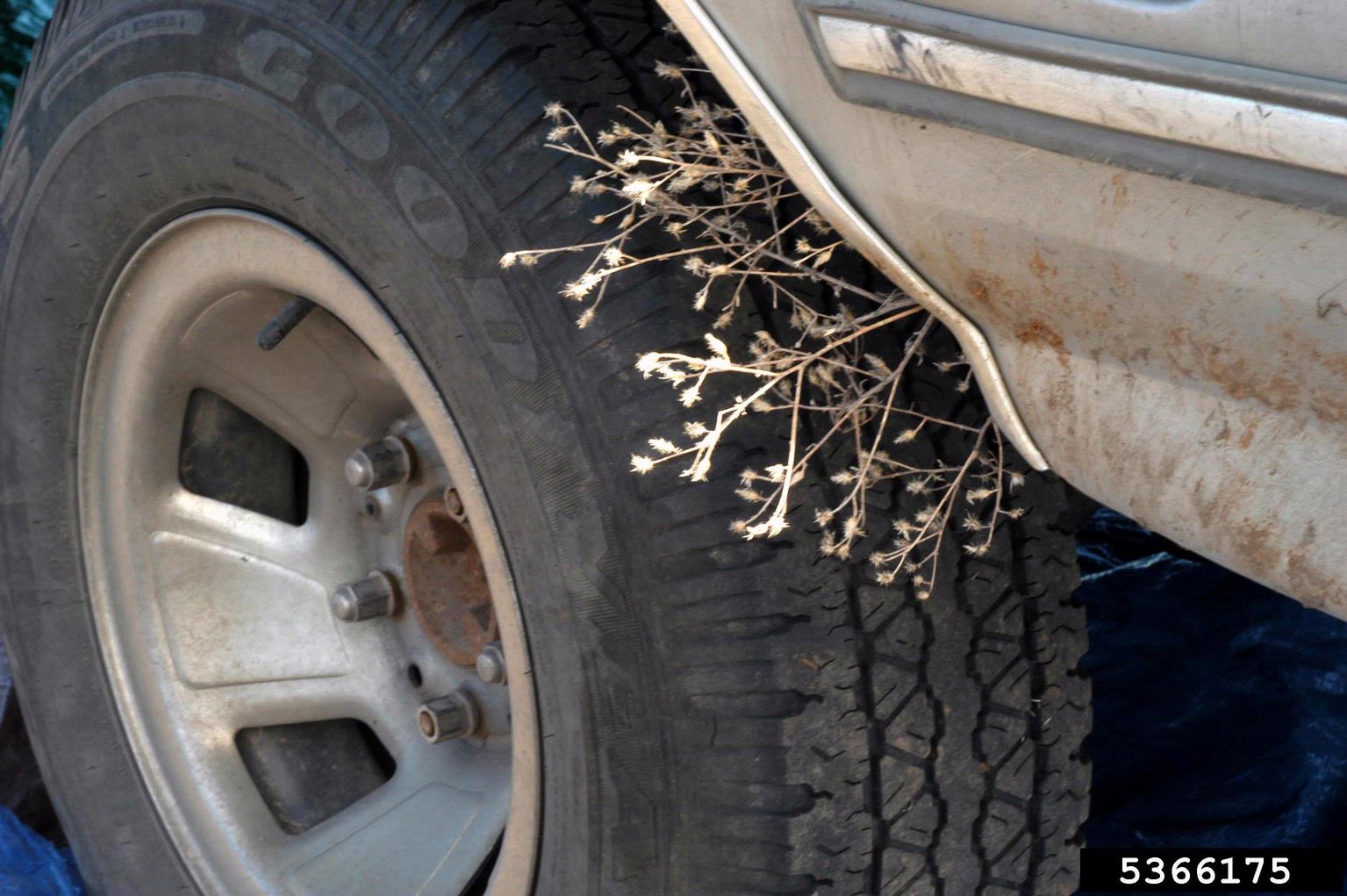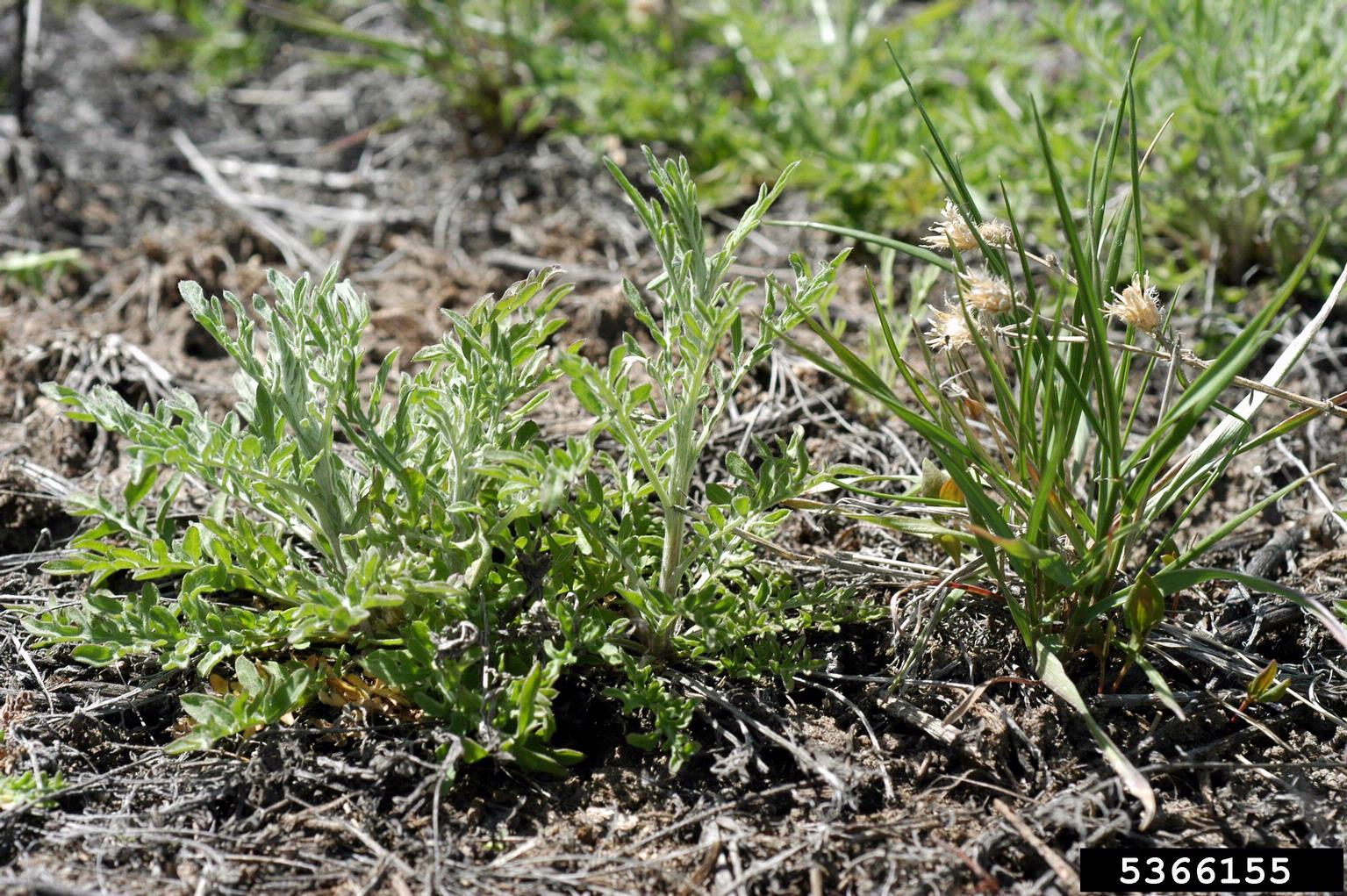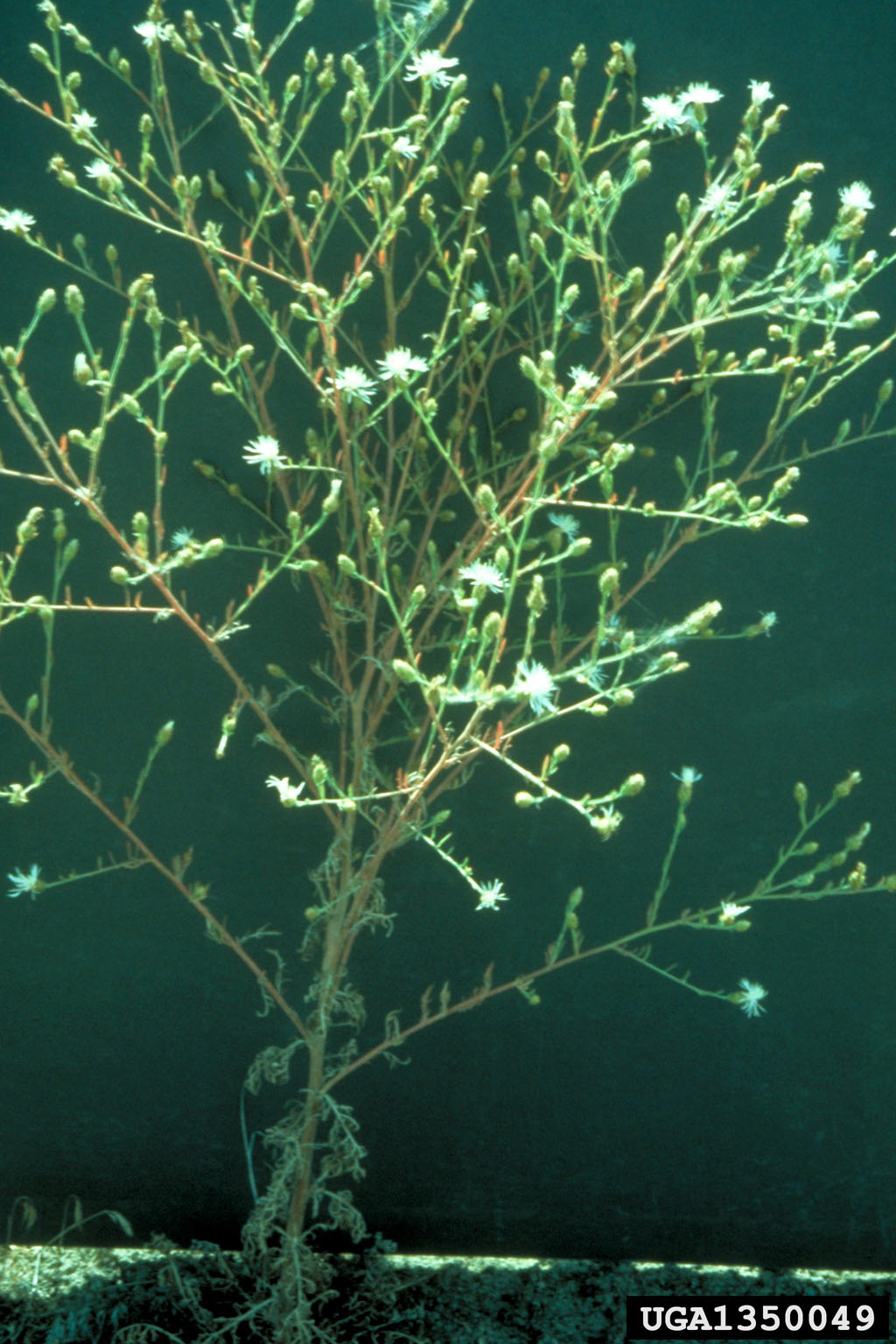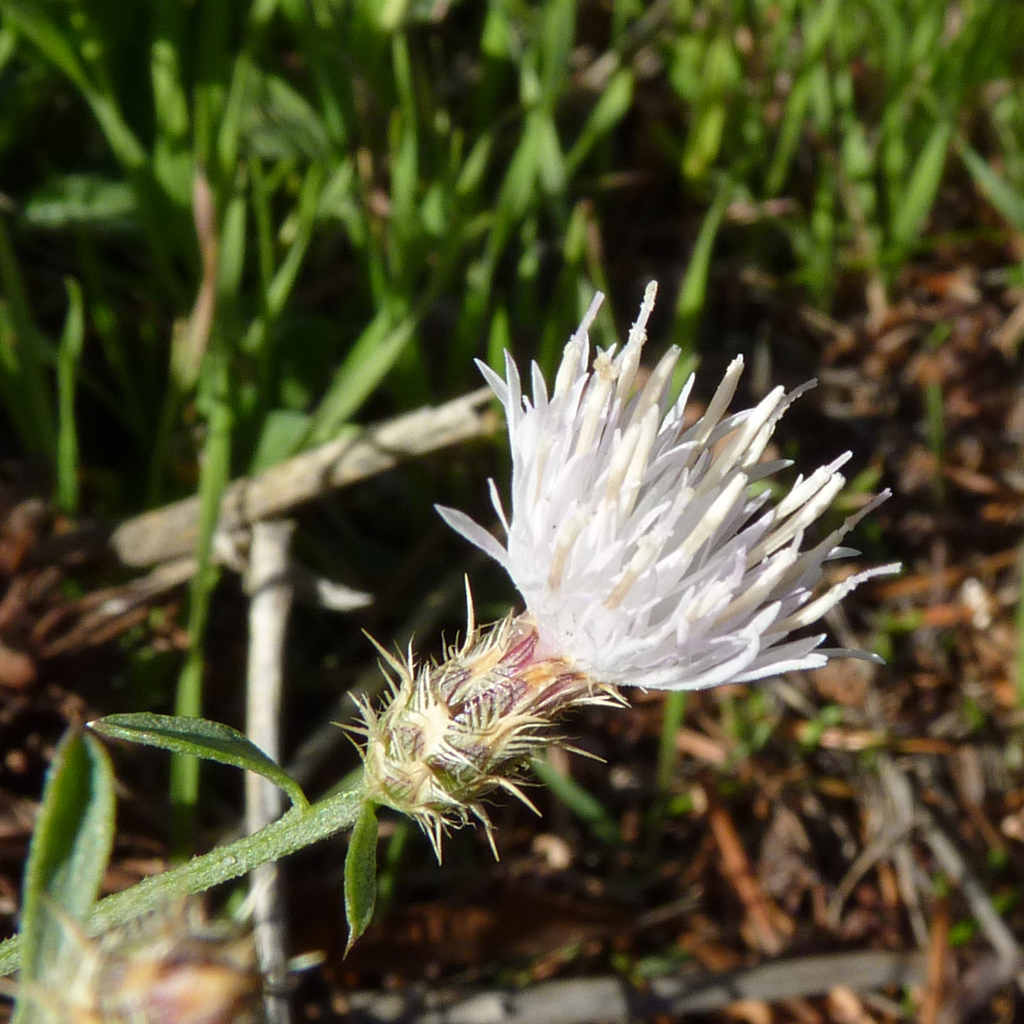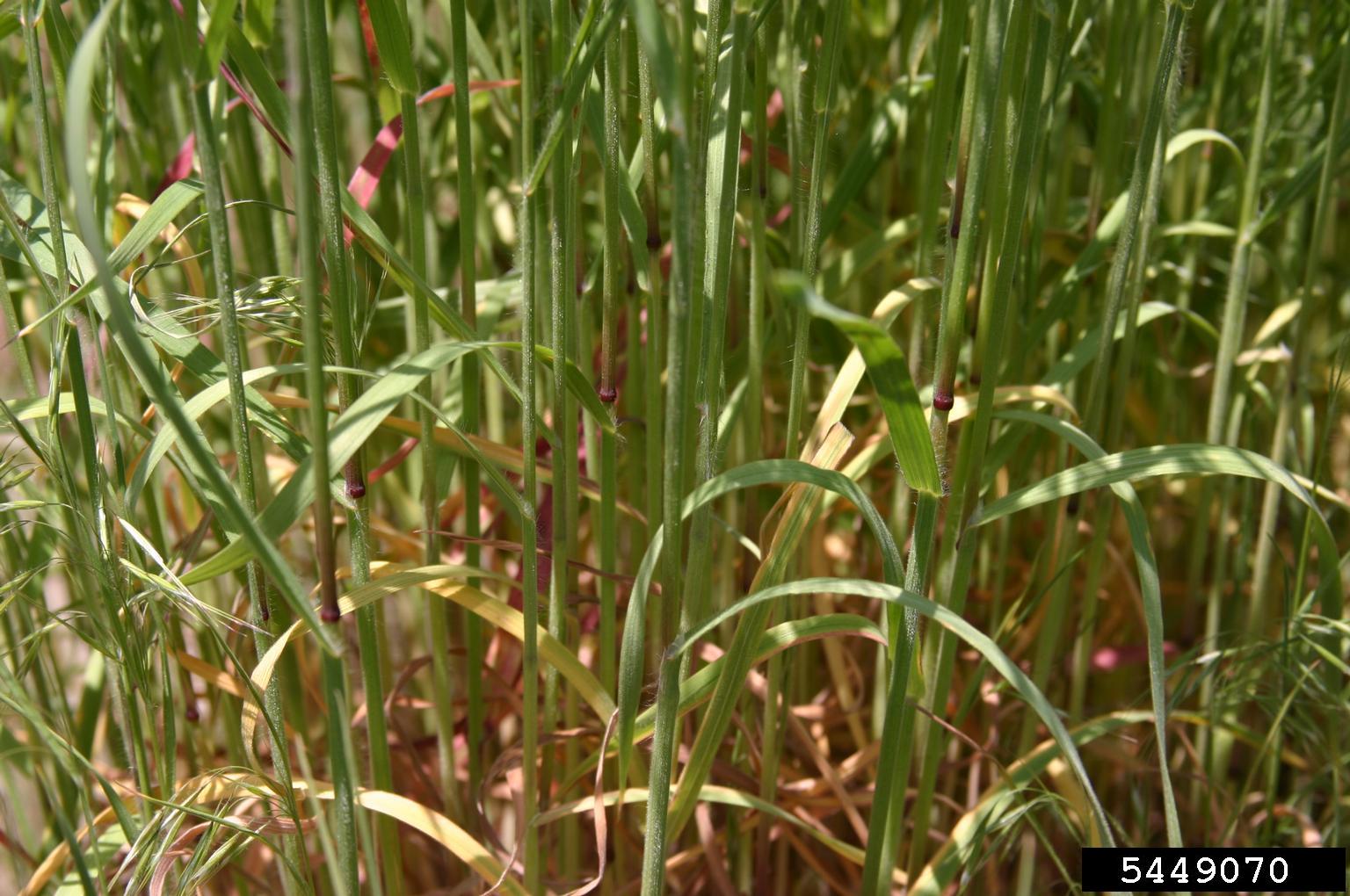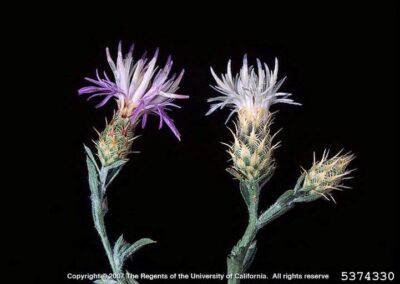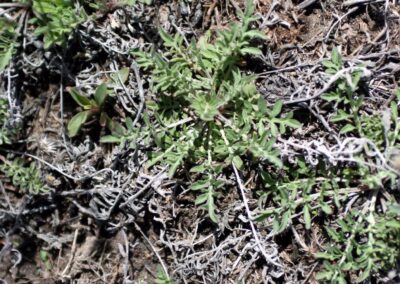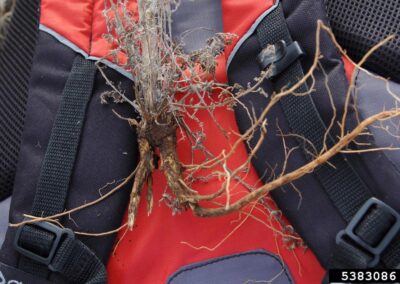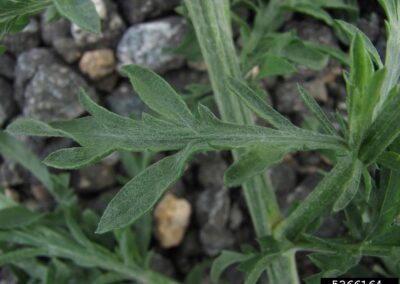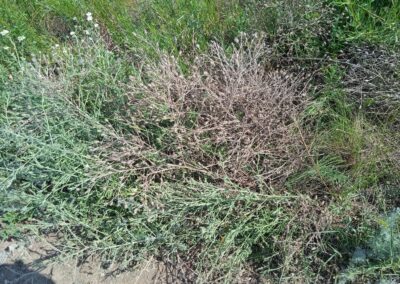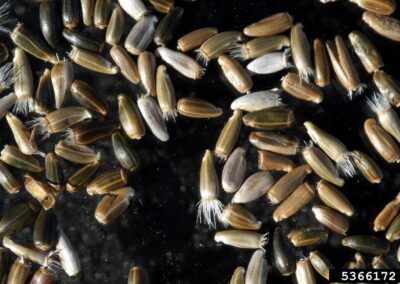
Diffuse Knapweed
Centaurea diffusa
Class A
Currently not present in New Mexico, or have limited distribution. Preventing new infestations of these species and eradicating existing infestations are the highest priorities.
Livestock Hazard
This plant presents a threat to the health and/or quality of livestock.
Agricultural Threat
This plant threatens our state’s food security and economy by reducing agriculture yields and/or degrading soil resources.
Local Ecosystems
This plant is detrimental to native ecosystems, negatively impacting the quality of forage for wildlife and reducing biodiversity in plant communities.
QUICK FACTS
- Diffuse Knapweed typically grows 1 to 5 feet tall. Once it reaches maturity, it grows, spreading branches that give the plant a ball-like appearance while providing it with tumbleweed-like mobility.
- Due to this weed’s invasiveness, it has a tendency to overtake disturbed lands, such as rangelands, open forests, pastures, roadsides, and vacant parking lots, thereby reducing the available space for other plants to grow while consuming most of the soil’s moisture.
- Since Diffuse Knapweed has spines that stick out from the base of the flower, cattle and wildlife run the risk of puncturing their mouths and stomachs when eating them due to the low grazing opportunities where Diffuse Knapweed is abundant.
1. Overview
An overwhelming infestation.
Due to the aggressive nature of this knapweed species, it tends to infest rangelands and pastures quickly and efficiently. It decreases the biodiversity of these lands, in turn reducing the value of these range lands while increasing the production costs for ranchers. It also increases soil erosion and requires more frequent roadside maintenance, as it often grows along right-of-ways. Due to its rapid growth and reproduction rate, it’s becoming increasingly complex to reduce the spread and population of Diffuse Knapweed. Considering that it can regrow from its root system, Diffuse Knapweed appears to be fire-resistant and has regrown in areas that have received fire treatment. [5,8,10]
History of Diffuse Knapweed
Diffuse Knapweed, native to the Eastern Mediterranean and Western Asia, was accidentally introduced to North America in the 1890s through contaminated seed and was first recorded in 1907, when it was discovered in an alfalfa field in Washington. Since then, its population has expanded into 204 counties and resides in 14 western states, including Colorado, North Dakota, New Mexico, and California. [3,4,6,9]
2. Identification
What does it look like?
Diffuse knapweed is a winter-hardy forb that usually grows as a biennial but may at times grow as an annual or short-lived perennial. Plants grow 1–3½ ft (0.3–1 m) tall, often have numerous spreading branches, and are supported by a long taproot. Weeds similar in appearance include spotted knapweed and purple starthistle. The primary difference is that diffuse knapweed has white flowers with petals that point upwards. [3,5,6,7]
Having trouble identifying a weed? Contact your local conservation district or county extension agent.
Key Features
- Roots: The plant has a deep and fibrous taproot that can grow more than 2.3 feet deep within the first 40 days. [5,6]
- Leaves: Leaves (4–8 in. long) are alternate, often covered with grayish hairs; lower leaves are deeply lobed; upper leaves are linear and entire. [5,6]
- Flowers: Consist of flower heads with white flower petals (sometimes either rose or purple colored). Each flower head is comprised of hundreds of florets. Below the flowers are several straw colored bracts with spiky tips. [3,5,6,9]
- Seeds: Each floret produces a single brown seed that has a tuft of soft, bristly hair. [3]
Joseph M. DiTomaso, University of California – Davis, Bugwood.org
Each flower head is comprised of hundreds of florets. Below the flowers are several straw colored bracts with spiky tips.
K. George Beck and James Sebastian, Colorado State University, Bugwood.org
Diffuse knapweed begins as a rosette with deeply lobed leaves.
K. George Beck and James Sebastian, Colorado State University, Bugwood.org
Leaves (4–8 in. long) are alternate, often covered with grayish hairs; lower leaves are deeply lobed; upper leaves are linear and entire.
Magazova Lubov, inaturalist.org
Plants grow 1–3½ ft (0.3–1 m) tall, and often have numerous spreading branches.
3. Infestation Basics
“Five species of the genus Centaurea (star thistle, diffuse, spotted, squarrose, and Russian knapweed ) have invaded millions of hectares of western United States and Canadian grasslands. Centaurea species are fundamentally different from the preexisting dominant species and may exploit changes in resource availability to become established.”
– Katherine D. Lejeune & Timothy R. Seastedt, 2002
Where and how does it grow, and how does it spread?
Diffuse Knapweed grows in disturbed soils and areas with frequent activity, such as range land, pastures, roadsides, ditches, open forests, and vacant lots. The only way that this particular knapweed spreads is through the seeds. [8,10]
Diffuse Knapweed is found in various locations due to its tolerance for different pH levels in the soil. This particular species thrives in disturbed soils and is notably resilient, even surviving in areas that have undergone fire thinning. Its method of propagation is through its seeds, which possess a tumbleweed-like mobility. This characteristic enables the seeds to roll and disperse in windy conditions after detaching from the parent plant, allowing Diffuse Knapweed to rapidly invade new areas.
Key takeaway: Diffuse knapweed spreads primarily through its seeds, which can travel easily in windy conditions, allowing the plant to invade new areas quickly. This species is adaptable to a wide range of soil pH levels and can even survive in environments that have experienced fire.
Why is it so invasive?
Diffuse knapweed can cause significant damage to the land. Whether pasture or agricultural land, it causes considerable damage to forage value and crop yield. This knapweed also displaces native plant species by reducing the availability of resources (food, water, sunlight) for them. [5]
Due to its aggressive and invasive nature, Diffuse Knapweed can rapidly overtake any disturbed area. This plant significantly reduces livestock forage, diminishes plant diversity, lowers land value, increases soil erosion, and heightens the need for roadside maintenance. With spines on the underside of its flower heads, Diffuse Knapweed poses a risk to wildlife and livestock, potentially causing harm to their mouths and stomachs. By monopolizing resources essential to native plant species, it contributes to a decline in plant diversity, ultimately leading to the extinction of these native species. The primary way it reduces land value is by leaving less room for grazable plants and adversely affecting agricultural yields as it attempts to eradicate surrounding vegetation. Additionally, Diffuse Knapweed proliferates along roadsides, which can lead to the deterioration of road edges and increase maintenance requirements.
Key takeaway: This plant can quickly grow out of control. Any area that sees frequent disturbance of any kind is susceptible to a Knapweed invasion.
Common risk factors for invasion
- Soil disturbance: Diffuse Knapweed loves to invade areas where soil has been disturbed, such as construction sites, tilled fields, or overgrazed pastures. This disruption weakens existing vegetation, allowing the weed to become established. Minimizing unnecessary soil disturbance can help reduce the risk of invasion.
- Areas of neglect: Diffuse Knapweed is often established in neglected or abandoned places, such as roadsides, railways, and vacant lots. These undisturbed spaces give it the time and opportunity to spread without competition or control. Regular monitoring and weed management in such areas can mitigate this risk.
- Open spaces: Diffuse Knapweed favors open, sunny environments with little to no canopy cover, such as pastures, cultivated fields, and south-facing slopes. These conditions allow the weed to establish quickly and outcompete other plants. Maintaining healthy, large-leafed vegetation in these areas can help limit its spread.
- Human activity: Diffuse Knapweed thrives in areas where the soil has been disturbed, such as construction sites, agricultural fields, roadsides, and other places where the natural vegetation has been disrupted. These disturbances create openings in the soil that allow the plant to become established in the first place. Additionally, the movement of soil, agricultural products, and equipment can inadvertently introduce weeds to new areas.
Impacts
Economic
This weed will develop into a monoculture due to its aggressive seed production and rapid vegetative growth. Aside from big game, it can reduce the available forage for domestic livestock and wildlife. Some wildlife will eat the knapweed willingly, but they only consume the rosettes due to the spines below the flowers, as there is a risk of injury to the animal’s mouth and stomach lining. Most of the consumption of these weeds (either by domestic livestock or wildlife) occurs during winter and early spring, due to the limited availability of forage from other plant life. [10]
Ecosystem Health
Once established, diffuse knapweed displaces native plants, resulting in loss of diverse plant life as well as any other forageable plants in the area. Due to the weed taking up all the moisture in the surrounding soil, it leaves no room for other plants to thrive. This then makes it harder for any herbivores to find a decent food source, which in turn reduces the predator population within the area as well. As soon as this weed can establish itself, there won’t be room for anything else. [10]
Erosion
Diffuse Knapweed significantly increases the risk of soil erosion by outcompeting and displacing native grasses and ground cover. Due to the weed’s weaker root structure compared to native grasses, it tends to be shorter, which causes erosion of the top layer of soil at a faster rate because it breaks up the soil more quickly. This leaves it vulnerable to water and wind erosion. The roots of diffuse knapweed release allelopathic biological compounds that reduce the soil’s integrity, thereby limiting the amount of resources available to native plant species. [5,10]
Infrastructure Issues
Diffuse Knapweed can penetrate through asphalt pavement. Due to this ability, it can drive up the cost of roadside maintenance exponentially. Since the weed thrives in disturbed areas, such as roadsides, for example, if there are cracks in the asphalt, it has the potential to grow within those cracks and further damage the road. [9]
Health & Safety
The weed is most hazardous when it has either reached full maturity or has fully died. The reason for this is that the spikes located on the bract of the plant (just below the flowerhead) are fully grown and have the potential to puncture the skin. Once it has fully dried, it becomes flammable, giving it the potential to carry fire effectively. [8,9,10]
4. Management Strategies
Managing diffuse knapweed effectively requires a combination of methods, including physical removal, biological control, cultural competition, and the use of herbicides when necessary. For small infestations, hand-pulling or digging out the taproot before flowering is an effective method. In larger areas, tillage can suppress established plants, but reseeding with competitive grasses is essential to reduce future growth.
DO’s
- Pull or dig plants before flowering, especially the second-year rosette stage, when the soil is moist, to remove the taproot and prevent regrowth.
- Reseed cleared areas with competitive perennial grasses or native plants to shade out knapweed and reduce seedbank replenishment.
- Clean vehicles, boots, livestock, and equipment after visiting infested sites to prevent the spread of seeds to new areas.
DON’Ts
- Never allow flowering if possible, because even cut or mowed plants may set seed at low heights.
- Disturb the soil excessively without revegetation, as this encourages seed germination and the growth of new seedlings.
- Compost flowering or seeding plants. Instead, place them in a bag and dispose of them in your household garbage or at an approved landfill.
** The following information is provided courtesy of the UC Weed Research and Information Center. nmweeds.org does not endorse the use of any particular product, brand, or application thereof. **
Physical and mechanical approaches to diffuse knapweed control include hand pulling, digging, tilling,disking, and cutting or mowing. Physical removal or damage can provide some control depending on the timing and frequency of treatment, the presence of competitive, desirable vegetation, and the level of soil disturbance caused by the treatment.
Mowing |
Mowing typically doesn’t kill knapweeds; cut plants generally survive and recover to set seed. Plants mowed at the rosette stage will quickly recover, and mowing too late (after seed set) can disperse seed. However, mowing at the late bud to early bloom stage will reduce seed production. Mowing can also remove dead growth to improve herbicide coverage. A program of cutting only bolted plants, particularly at the early bloom stage, for several consecutive years, can greatly suppress diffuse knapweed. Cultivation is effective when repeated, but diffuse knapweed typically grows in areas not conducive to tillage. |
Tilling/Hand-pulling, etc |
Hand pulling is practical for scattered diffuse knapweed plants, or for areas where other control methods are not feasible and sufficient labor is available. Repeated hand pulling is necessary during the season and over many years. Successful control has been reported when plants were hand removed 3 times a year (spring, summer, and late summer) over a period of 5 years. Every effort should be made to remove the entire taproot with little soil disturbance. If not possible, then cut the root 2 to 4 inches below the soil surface to remove much of the reproductive crown. Gloves should be worn when hand pulling. The best timing for hand removal is before plants produce viable seed. Hand pulling has not been effective in all areas. On dry soils, it may be difficult to remove the root crown and this can lead to rapid reestablishment. |
Grazing |
Grazing is not an effective eradication method. Diffuse knapweed is not typically considered palatable to livestock. Furthermore, intensive grazing can create ideal seedbeds for further invasion. However, researchers have shown that cattle, sheep, and goats will readily graze diffuse knapweed in early spring. Cattle grazing twice in spring decreased seed production by 50%. Sheep typically graze diffuse knapweed from the rosette through the bud stage or when it is the only plant available. The timing of grazing may be critical to its success. Although there is no direct evidence, it is likely that the optimal timing would be similar to that of spotted knapweed. For spotted knapweed, early and late-season grazing appear to be the most effective timing with sheep: early season (spring) to reduce flower production, and late season (fall) to reduce the density of young plants. In one study, two consecutive years of early and late sheep grazing reduced spotted knapweed but had little effect on the native grass community. |
Prescribed burns |
Diffuse knapweed is adapted to survive fire and to take over recently burned areas, so burns are not recommended as a control strategy. |
Currently, there is no single biological control agent that effectively controls diffuse knapweed populations. However, numerous biocontrol insects from diffuse knapweed’s native range are established in the United States, including flies and weevils that attack seedheads. These include the banded gall fly (Urophora affinis), knapweed seedhead fly (U. quadrifasciata), knapweed peacock fly (Chaetorellia acrolophi), lesser knapweed flower weevil (Larinus minutus), and broad-nosed seedhead weevil (Bangasternus fausti). Larinus minutus, in particular, is an aggressive and effective biocontrol insect for diffuse and spotted knapweed.
Root-feeding insects may have a more detrimental effect on knapweed populations than seed-feeding ones. Larvae of the diffuse knapweed root beetle (Sphenoptera jugoslavica) feed in the roots of diffuse
knapweed. Larvae of the moths Agapeta zoegana and Pterolonche inspersa and the weevil Cyphocleonus achates feed in the roots of both diffuse knapweed and spotted knapweed. The collective stress on the plant caused by these insects sharply reduces seed production and may lead to reduced competitiveness. However, they have not been shown to reduce diffuse knapweed plant densities significantly.
Information regarding chemical management strategies for this plant has been provided by the UC Weed Research and Information Center.
“The following specific use information is based on published papers and reports by researchers and land managers. Other trade names may be available, and other compounds also are labeled for this weed. Directions for use may vary between brands; see label before use. Herbicides are listed by mode of action and then alphabetically. The order of herbicide listing is not reflective of the order of efficacy or preference.”
2,4-D
|
|
Aminocyclopyrachlor +
|
|
Aminopyralid
|
|
Clopyralid
|
|
Clopyralid + 2,4-D
|
|
Dicamba
|
|
Picloram
|
|
Glyphosate
|
|
Imazapyr
|
3 to 4 pt product/acre has been shown to give some level of control. |
5. References
References
[1] “Diffuse Knapweed | National Invasive Species Information Center,” www.invasivespeciesinfo.gov. https://www.invasivespeciesinfo.gov/terrestrial/plants/diffuse-knapweed (accessed Jun. 13, 2025
[2] “USDA Plants Database,” Usda.gov, 2025. https://plants.usda.gov/plant-profile/CEDI3 (accessed Jun. 13, 2025).
[3] “Diffuse knapweed | Department of Agriculture,” Colorado.gov, 2024. https://ag.colorado.gov/conservation/noxious-weeds/noxious-weed-species-id/diffuse-knapweed (accessed Jun. 13, 2025)
[4] T. C. W. and P. D. n /a, “Diffuse Knapweed | Invasive Plant in Teton County, WY,” Tcweed.org, 2023. https://www.tcweed.org/invasive-plants/diffuse-knapweed (accessed Jun. 26, 2025).
[5] G. University, “diffuse knapweed (Centaurea diffusa Lam.) – EDDMapS,” EDDMapS.org, 2023. https://www.eddmaps.org/species/subject.cfm?sub=4472 (accessed Jun. 26, 2025).
[6] “Category B-Medium,” Bureau Of Indian Affairs. Accessed: Jun. 26, 2025. [Online]. Available: https://www.bia.gov/sites/default/files/media_document/diffuse_knapweed.pdf
[7] “Noxious and Troublesome Weeds of New Mexico | New Mexico State University – BE BOLD. Shape the Future.” Nmsu.edu, 2025. https://pubs.nmsu.edu/_circulars/CR698/#a8 (accessed Jun. 26, 2025).
[8] “DIFFUSE KNAPWEED (Centaurea diffusa).” Accessed: Jun. 26, 2025. [Online]. Available: https://www.library.nd.gov/statedocs/AgDept/Diffuseknapweed20070703.pdf
[9] “Diffuse Knapweed – Adams County Extension,” Colostate.edu, 2025. https://adams.extension.colostate.edu/ag-acreage/diffuse-knapweed/ (accessed Jun. 26, 2025).
[10] “Fire Effects Information System (FEIS).” Available: https://www.fs.usda.gov/database/feis/plants/forb/cendif/all.pdf (accessed Jun. 26, 2025)
[11] And, “Diffuse Knapweed,” Methow Conservancy, 2025. https://methowconservancy.org/weeds/diffuse-knapweed (accessed Jul. 02, 2025).
[12] T. Bishopp, “Knap-Time,” On Pasture, Jul. 28, 2015. https://onpasture.com/2015/07/27/knap-time-2/ (accessed Jul. 02, 2025).
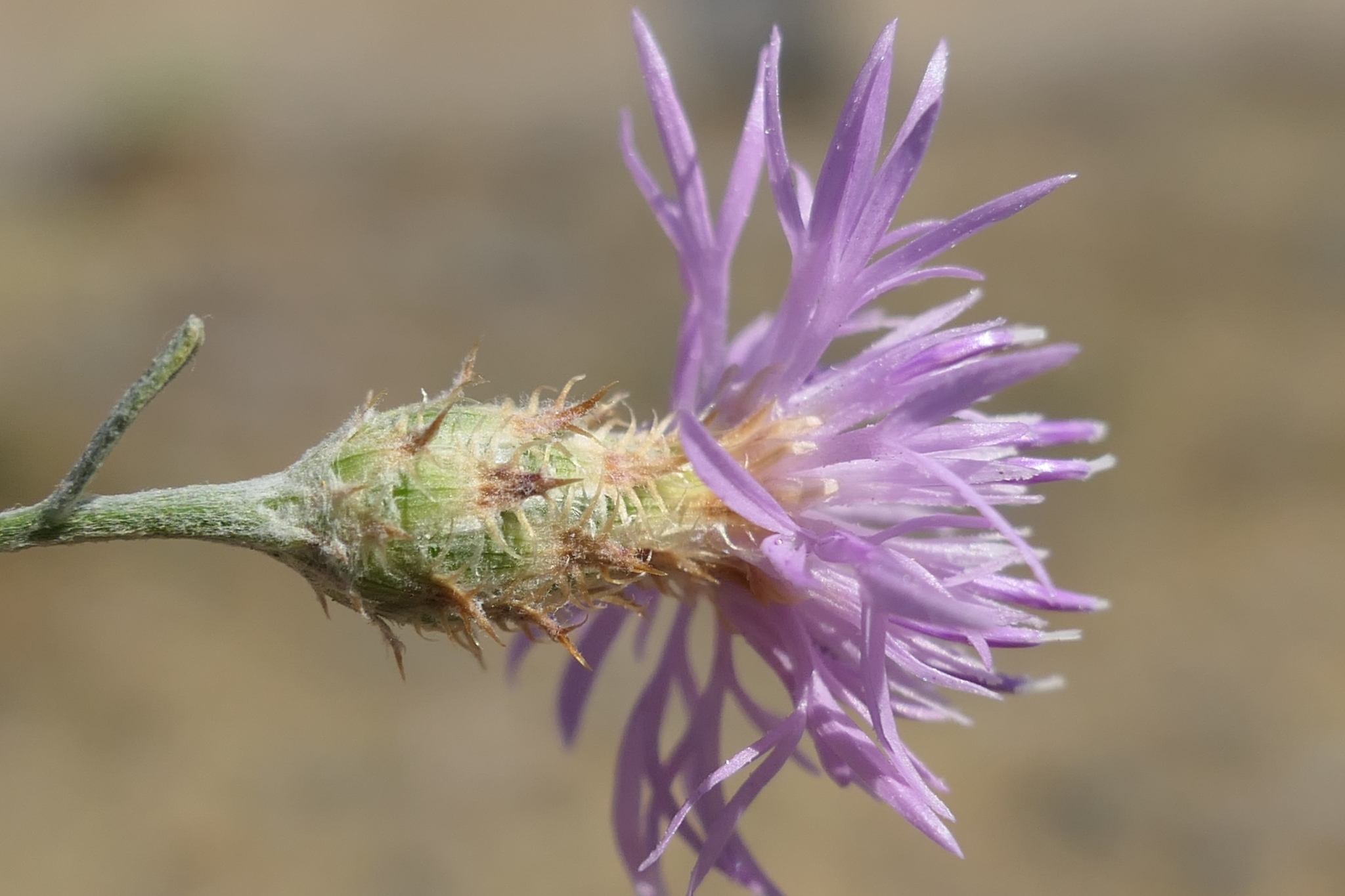
Markus Ackermann, inaturalist.org
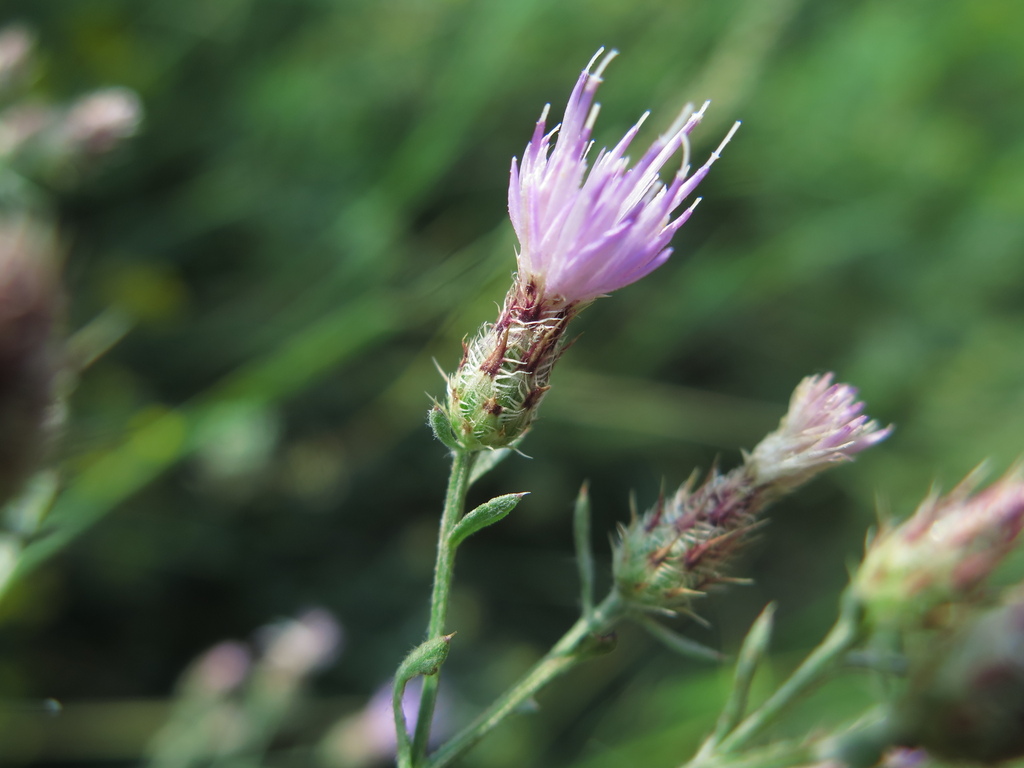
tavridaalex, inaturalist.org
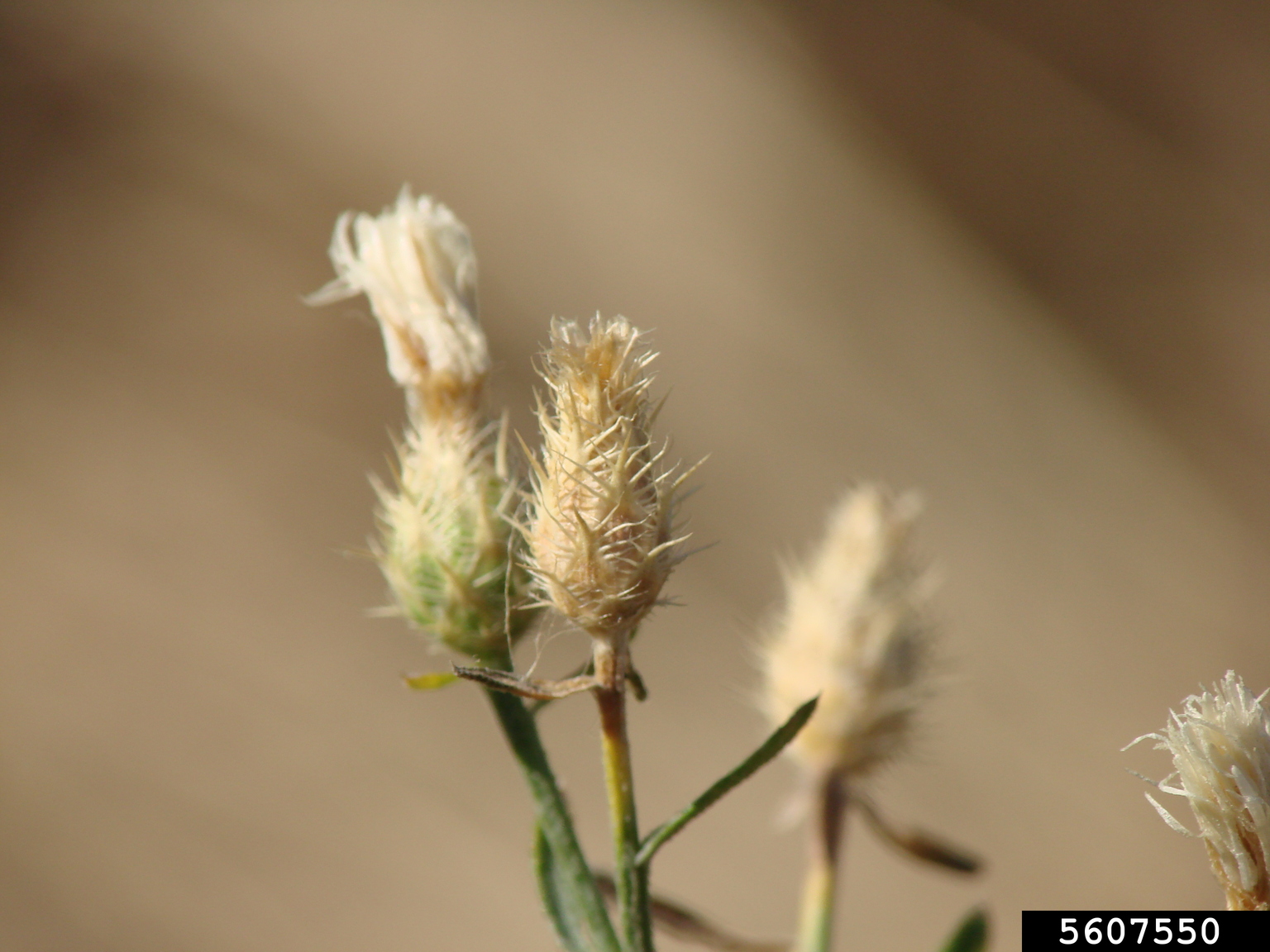
Jennifer Andreas, Washington State University, Bugwood.org
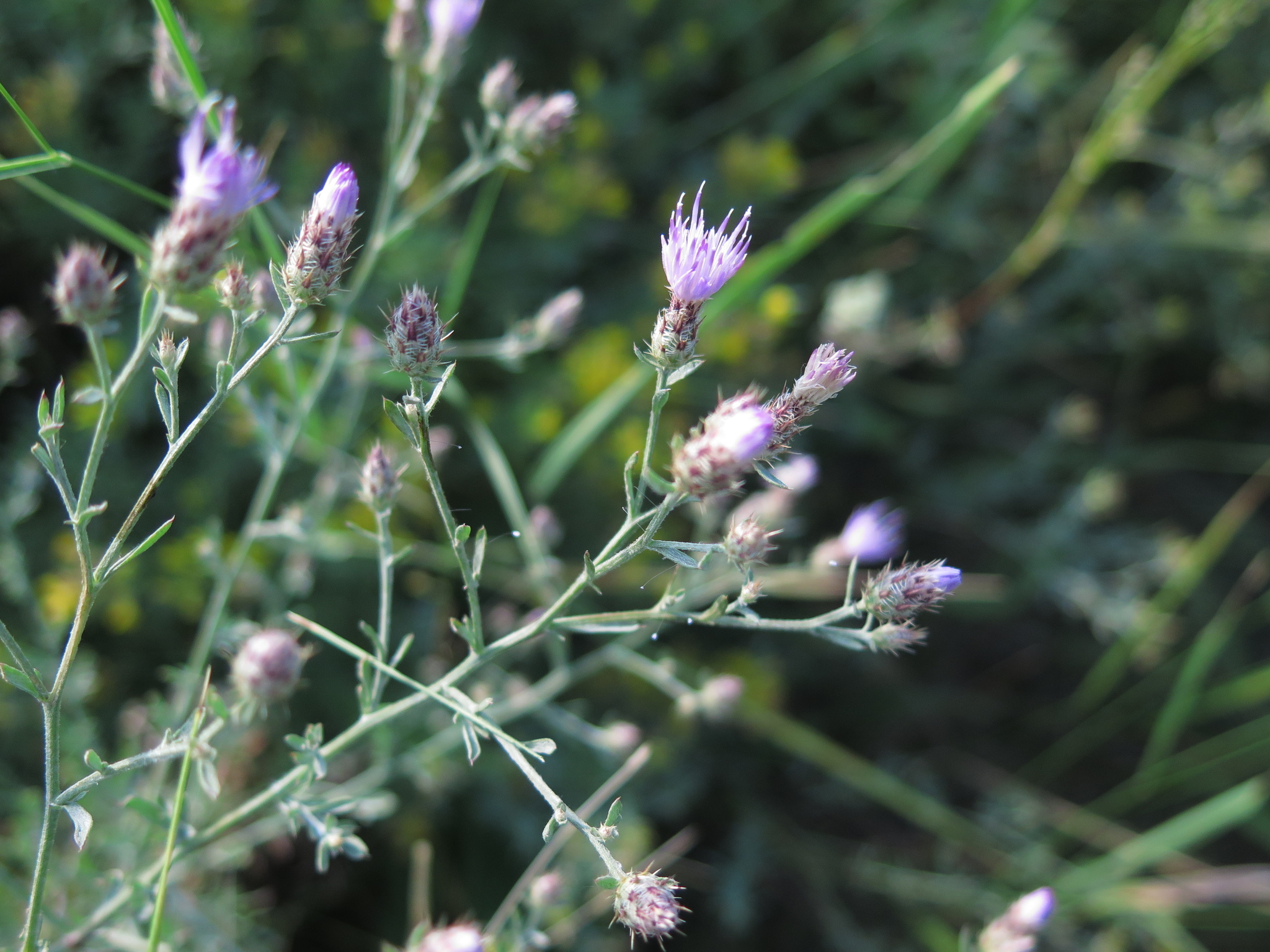
tavridaalex, inaturalist.org
